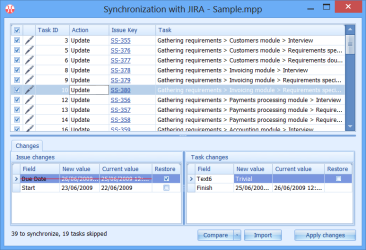If you are a project manager or team leader you probably use Microsoft Project to keep your teams and projects organized and scheduled.After more than 20 years on the market, MS Project is still the preferred project management tool by enterprises and small and midsize business alike. This software was designed to efficiently plan projects through structured tasks and work packages, budget and manage costs, bill and quote clients, and more. A once cutting-edge management tool, it still holds its value today. It is especially useful for those who use Waterfall management models.
However, MS project falls short when it comes to Agile and Hybrid PM approaches because of the need for real-time syncing. Another disadvantage of Microsoft Project lies in the fact that you can´t plan issues in detail below the tasks. This is where Atlassian JIRA comes to play. JIRA is a project management tool that lets you plan detailed issues in sprints and iterations, as well as real-time progress tracking. These, in turn, boost teamwork by providing an efficient way to manage each stage of a project.You are probably wondering how you can get the best of both tools. The short answer to that question is a Jira MS Project integration.

Using the right plugin to integrate these two PM tools will allow you to have the best of both worlds in one smooth operation, making your project management approach easier to handle while keeping all members of your team or teams updated about the progress of each stage of the projects, and the ability to create projects of any size.
Here are some of the advantages of cross-system data exchange between JIRA and MS Project:
- You can plan, program, and track values in MS Project while collaborating and reporting progress in JIRA. With an integration such asCeptah Bridge you won’t need to worry about synchronization.
- The members of your team will be able to choose the tool that best suits their needs for their individualactivities while collaborating on tasks and sending progress reports on the team-based activities.
- You can import from JIRA to MS Project, create issues, and synchronize both ways. JIRA issues can be generated based on MS Project taskswhile existing issues, including subtasks, can be exported from JIRA to MS Project
- You can tailor the product to each project´s specific needs by running VBA macros during any stage of synchronization.
- Updated informationis efficiently provided for all the members involved in the project.
- It reduces the effort of planning and updating the different phases of a project.
- It provides data reliability. This allows for appropriate and efficient decision making, which is crucial to the success of any project.
- It provides data consistency in all involved systems and for all team members.
These are only some of the advantages of a JIRA MS Project integration. Using both project management systems will allow you to build an efficient solution that is tailored to the specific needs of each project you manage with virtually no additional effort, enabling automated data flow and avoiding the need for entering information twice.
